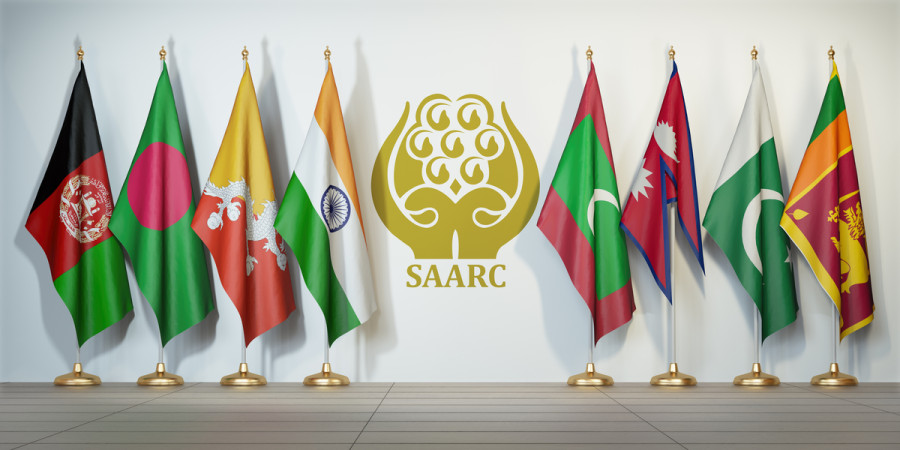Columns
Regional economic development in South Asia
India is the only SAARC country that has the expertise and capital to set up joint ventures in the region.
Suman Kumar Regmi
The volume of legal intraregional trade in South Asia is quite insignificant, resulting in limited interdependence among the countries in the region. Commerce among SAARC (South Asian Association for Regional Cooperation) countries, compared to their trade with other countries, remains low and stagnant. Except for the Maldives and Nepal, intraregional imports and exports of all SAARC countries are negligible. Although intraregional imports of Bangladesh and Sri Lanka showed some improvement, their legal exports to the region have declined. The extremely low level of intraregional imports and exports of India and Pakistan indicates how little these two relatively developed economies depend on the region's markets.
Only India among SAARC countries has the experience, expertise, technology and capital to fund and set up joint ventures in the region. Indian technology can be appropriately scaled down to local conditions and is less demanding of scarce capital and foreign exchange resources. Despite this fact, not much Indian investment has taken place in the region owing to political issues and a general suspicion of India's intentions.
Hydropower potential
It is estimated that the Himalayan rivers flowing through Nepal have a hydropower potential of 83,000 megawatts, while in India, Bangladesh and Pakistan, the estimated hydropower potential is about 70,000 megawatts, 1,772 megawatts, and 21,000 megawatts respectively. It is encouraging to note that in Bhutan, another country with enormous hydropower potential, the Chukha hydroelectric project was completed some years ago with India's assistance. This has benefitted some SAARC countries.
Economic reforms in India and Pakistan would have provided SAARC countries an opportunity to diversify their exports and make manufacturing products more competitive. But the success of their economic liberalisation essentially depends upon their ability to find new markets in the developed and developing countries. Two developments in the international environment make prospects of South Asian exports to new markets less promising. The world economy is experiencing weak growth or less than 5 percent. Thus, it will be difficult for South Asian countries to expand exports rapidly. With the formation of regional economic blocs and growing protectionism in the developed and developing regions, South Asia may find it difficult to gain access to these markets.
Thus, the international environment and domestic needs within SAARC are conducive for expanding regional cooperation in South Asia. It is often argued that if South Asian countries are able to increase their intraregional trade to more than 7 percent, they will be able to set up regional joint ventures and share the available technology. As a result, there will be a considerable improvement in the region's interdependence and economy. South Asian policymakers seem to be realising this. The implementation of SAFTA (South Asian Free Trade Area) by all SAARC members is a move in the right direction in promoting intraregional interdependence.
Given the low level of mutual trust, spillover effects of ethnic and religious conflicts, and magnitude of bilateral disputes in South Asia, it is unrealistic to believe that any substantial growth in regional cooperation will be possible without first easing political tensions. Until then, SAARC is likely to experience only a 'run and run and stop' pattern of growth under which limited pragmatic cooperation in specific techno-economic issues is possible over a period of time.
In the post-2000 and 2010 period, some realisation seems to have dawned among South Asian leaders that the future of SAARC, like any other regional grouping, lies in concentrating on economic cooperation in specific areas. The renewed emphasis SAARC leaders have put on increasing intraregional trade at their summit meetings is evidence of their growing willingness to enhance economic cooperation in South Asia. But how soon and to what extent they are going to achieve success remains unclear.
Any realistic assessment of the prospects for increased economic cooperation and interdependence has to address the following issues. The first issue pertains to the role of the state in promoting regional cooperation. Given the limited political contacts and mutual security concerns arising out of a typical security complex in South Asia, a state-directed approach to economic cooperation is better suited to this region.
South Asian countries may be weak and imperfect, but certainly not irrelevant in initiating or guiding regional cooperation policies and promoting economic interdependence. Considering the limited development of transnational market forces, any prospect of the growth of regional economic cooperation driven exclusively by market forces appears bleak. Besides, if regional economic cooperation is left to market forces alone, it will take decades. Therefore, conscious efforts at the political level and a demonstration of political will by South Asian leaders are absolutely necessary for the growth of regional economic cooperation.
Economic interdependence
Another issue concerns the development of realistic economic interdependence in South Asia. The key to the development of a pragmatic strategy to increase economic interdependence among South Asian countries is to promote intraregional trade by lowering tariffs without delinking from extra-regional and global economic relations.
For decades, South Asian countries have suffered from the degradation of their natural resource base and environmental pollution because of their overuse and often misuse of natural resources. Efficient use of the natural resource base and environmental conservation should be given utmost priority by South Asian countries to meet their growing energy needs and alleviate the health risks to their population. Given the integrated environment of South Asia, it is essential for SAARC countries to collectively think of strategies for environmental conservation. This will require policy coordination at the governmental and grassroots levels. Finally, it is necessary to activate the South Asian Development Fund in order to provide financial support to regional projects.
***
What do you think?
Dear reader, we’d like to hear from you. We regularly publish letters to the editor on contemporary issues or direct responses to something the Post has recently published. Please send your letters to [email protected] with "Letter to the Editor" in the subject line. Please include your name, location, and a contact address so one of our editors can reach out to you.




 6.1°C Kathmandu
6.1°C Kathmandu















